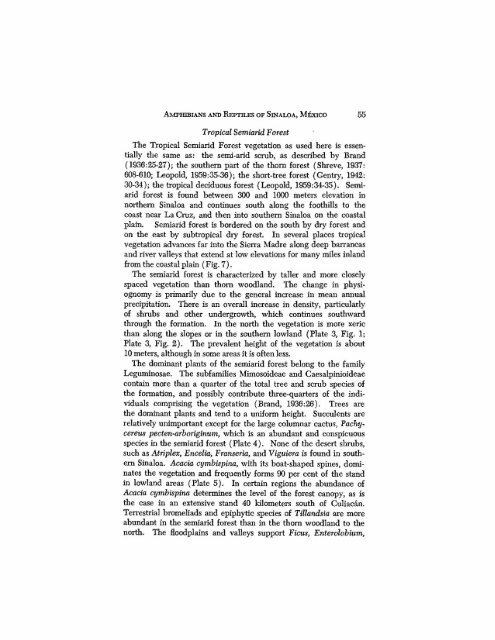The Amphibians and Reptiles of Sinaloa, Mexico - Smithsonian ...
The Amphibians and Reptiles of Sinaloa, Mexico - Smithsonian ...
The Amphibians and Reptiles of Sinaloa, Mexico - Smithsonian ...
You also want an ePaper? Increase the reach of your titles
YUMPU automatically turns print PDFs into web optimized ePapers that Google loves.
AMPHIBIANS AND REPTILES OF SINALOA, <strong>Mexico</strong> 55<br />
Tropical Semiarid Forest<br />
<strong>The</strong> Tropical Semiarid Forest vegetation as used here is essentially<br />
the same as; the semi-arid scrub, as described by Br<strong>and</strong><br />
(1936:25-27); the southern part <strong>of</strong> the thorn forest (Shreve, 1937:<br />
608-610; Leopold, 1959:35-36); the short-tree forest (Gentry, 1942:<br />
30-34); the tropical deciduous forest (Leopold, 1959:34-35). Semiarid<br />
forest is found between 300 <strong>and</strong> 1000 meters elevation in<br />
northern <strong>Sinaloa</strong> <strong>and</strong> continues south along the foothills to the<br />
coast near La Cruz, <strong>and</strong> then into southern <strong>Sinaloa</strong> on the coastal<br />
plain, Semiarid forest is bordered on the south by dry forest <strong>and</strong><br />
on the east by subtropical dry forest. In several places tropical<br />
vegetation advances far into the Sierra Madre along deep barrancas<br />
<strong>and</strong> river valleys that extend at low elevations for many miles inl<strong>and</strong><br />
from the coastal plain (Fig. 7).<br />
<strong>The</strong> semiarid forest is characterized by taller <strong>and</strong> more closely<br />
spaced vegetation than thorn woodl<strong>and</strong>. <strong>The</strong> change in physiognomy<br />
is primarily due to the general increase in mean annual<br />
precipitation. <strong>The</strong>re is an overall increase in density, particularly<br />
<strong>of</strong> shrubs <strong>and</strong> other undergrowth, which continues southward<br />
through the formation. In the north the vegetation is more xeric<br />
than along the slopes or in the southern lowl<strong>and</strong> (Plate 3, Fig. 1;<br />
Plate 3, Fig. 2). <strong>The</strong> prevalent height <strong>of</strong> the vegetation is about<br />
10 meters, although in some areas it is <strong>of</strong>ten less.<br />
<strong>The</strong> dominant plants <strong>of</strong> the semiarid forest belong to the family<br />
Leguminosae. <strong>The</strong> subfamilies Mimosoideae <strong>and</strong> Caesalpinioideae<br />
contain more than a quarter <strong>of</strong> the total tree <strong>and</strong> scrub species <strong>of</strong><br />
the formation, <strong>and</strong> possibly contribute three-quarters <strong>of</strong> the individuals<br />
comprising the vegetation (Br<strong>and</strong>, 1936:26). Trees are<br />
the dominant plants <strong>and</strong> tend to a uniform height. Succulents are<br />
relatively unimportant except for the large columnar cactus, Packycereus<br />
pecten-arboriginttm, which is an abundant <strong>and</strong> conspicuous<br />
species in the semiarid forest (Plate 4). None <strong>of</strong> the desert shrubs,<br />
such as Atriplex, Encelia, Franseria, <strong>and</strong> Viguiera is found in southem<br />
<strong>Sinaloa</strong>. Acacia cymbispina, with its boat-shaped spines, dominates<br />
the vegetation <strong>and</strong> frequently forms 90 per cent <strong>of</strong> the st<strong>and</strong><br />
in lowl<strong>and</strong> areas (Plate 5). In certain regions the abundance <strong>of</strong><br />
Acacia cymbispina determines the level <strong>of</strong> the forest canopy, as is<br />
the case in an extensive st<strong>and</strong> 40 kilometers south <strong>of</strong> Culiacan.<br />
Terrestrial bromeliads <strong>and</strong> epiphytic species <strong>of</strong> Till<strong>and</strong>sia are more<br />
abundant in the semiarid forest than in the thorn woodl<strong>and</strong> to the<br />
north. <strong>The</strong> floodplains <strong>and</strong> valleys support Ficus, Enterolobium,
















